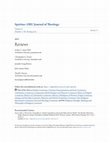Book Reviews by Jennifer L Greig-Berens

Spiritus: ORU Journal of Theology, 2019
A unified theology of worship from the Pentecostal perspective seems to be a daunting task given ... more A unified theology of worship from the Pentecostal perspective seems to be a daunting task given that Pentecostals value what Lee Roy Martin describes as “spontaneity and liberty” in worship over more formulaic liturgies. Nevertheless, Martin praises the creativity of the diverse voices that contribute fifteen essays to theological reflection on the topic and challenges the reader to identify a continuity in thought and shared ethos among the various contributors. The general characterization of Pentecostal worship in this book is consistent with the universal function of worship as theocentric praise and anthropological service to God. However, three overarching convictions can be discerned that demonstrate a shared Pentecostal ethos: (1) an expectation of divine encounter in the context of worship, (2) an anticipation of a personal and/or communal transformative experience in worship, and (3) an emphasis on the Spirit as the agent of encounter and transformation in the context of the Pentecostal worship service. The contributors to the book under review identify the worship service as the sacred space where Pentecostals practice their distinctive doctrines of the Holy Spirit.
Papers by Jennifer L Greig-Berens

Jezebel is an infamous character of the Hebrew Scriptures; she is well known, her villainy legend... more Jezebel is an infamous character of the Hebrew Scriptures; she is well known, her villainy legendary, and her name, perhaps excessively, used as a typology in the Church today. Jezebel is the quintessential evil woman. However, the Church, as well as current feminist theologians, have often neglected to consider, collectively, the historical, biblical, and theological context that defines her. Chapter one presents the historical, theological, and literary context of the biblical acccount of Jezebel. Chapter two exegetes the prophetic narratives regarding the reign of Ahab and Jezebel, focusing on 1 Kings 16-19. Chapter three exegetes 1 Kings 21 and 2 Kings 9-10. This final chapter and conclusion focuses on the Hebraic terminology utilized to portray the biblical Jezebel. Based on historical context, the theological purpose of the Book of Kings, and the prophetic narratives, the author identifies Jezebel as the religious antagonist behind the ongoing prophetic struggle against the implementation of Baal worship in ninth-century B.C. Israel. ACKNOWLEDGMENTS Foremost, I would like to thank my Father and my Savior, the Lord Jesus Christ, Through whom all things have come and through whom we live (1 Cor 8:6), and for the direction of the Holy Spirit throughout this endeavor. Many thanks to my beloved Nicholaus, for his undying love and support through the entire process of bringing this vision to fruition. I am grateful for the supportive staff and faculty of Oral Roberts University School of Theology and Ministry, chiefly for the guidance and patience of my reader, Dr.
Books by Jennifer L Greig-Berens

The author proposes a process of ritualization for the cognitive embodiment of a priestly self-un... more The author proposes a process of ritualization for the cognitive embodiment of a priestly self-understanding among women who were members of John’s early Christian audience in Asia Minor. The priestly identity is scripted in two hymnic units which employ the literary feature of the rhetorical “us” (Rev 1:6a; 5:10a). The rhetorical feature is part of the ritual-liturgical and priestly discourse of the Apocalypse. A communal embodiment of the priesthood takes place when the audience vocalizes the scripted utterance as a speech act. The author argues that the speech acts in the hymnic units were part of a covenant renewal liturgy that is now embedded in the text. A ritual investiture of the priesthood takes place when the liturgy is enacted in the liturgical life of the audience. The priestly identity is further cultivated in the consciousness of the audience through the vivid depiction of a corresponding liturgy that is performed by the heavenly priests in the celestial temple. The application of speech act theory and ritual theory alongside a form-critical analysis of the hymns supports the thesis that John’s Apocalypse was read aloud in public worship for the purpose of cultivating a sense of liturgical communion with the heavenly priests and a transcendent experience of present participation in priestly service before the merkavah throne. Antecedent liturgies found in the Hebrew Bible and Second Temple Jewish literature provide a rich literary milieu for understanding the coordination of the worship of the priests on earth with the priests in heaven.











Uploads
Book Reviews by Jennifer L Greig-Berens
Papers by Jennifer L Greig-Berens
Books by Jennifer L Greig-Berens